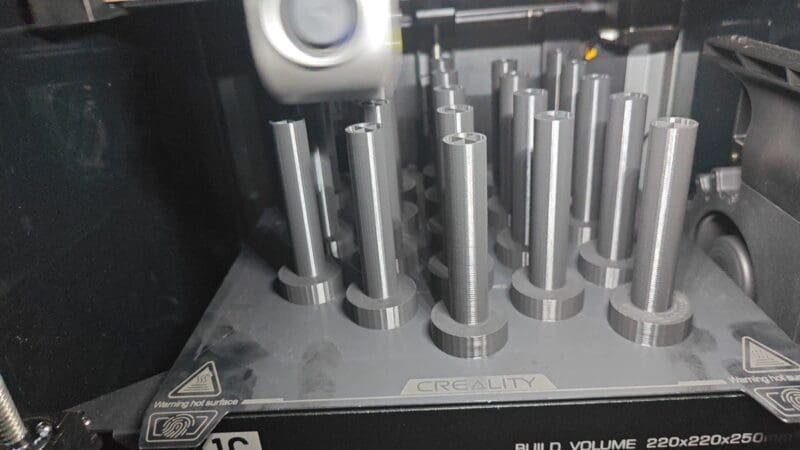ASA vs ABS: The Battle of 3D Printing Filaments

Introduction
Welcome to the world of 3D printing filaments! The battle between ASA vs ABS has been ongoing. As the 3D printing industry evolves, makers and enthusiasts need to stay informed about the materials driving this revolution.
In this article, we’ll compare ABS and ASA in terms of their durability, UV resistance, and eco-friendliness. We’ll explore their applications and uses, helping you make informed choices for your 3D printing projects.
Whether you’re a seasoned 3D printing professional or a newcomer eager to learn, this article will provide you with the knowledge to navigate the ABS vs. ASA debate and take your 3D printing endeavors to new heights. Let’s dive in and discover the clash of these tough filaments.
Comparison: ASA vs ABS
When it comes to choosing the right filament for your 3D printing projects, the battle between ABS and ASA is a hot topic. Both materials have their unique properties and characteristics that make them suitable for various applications. In this section, we will compare ABS and ASA to help you make an informed decision.
Durability and Strength: ABS is known for its robust and durable nature, making it ideal for applications that require resistance against physical impacts. ASA, on the other hand, offers commendable mechanical properties, ensuring reliable and functional prototypes and end-use products.
Temperature Resistance: ABS boasts high-temperature resistance, which is essential for components exposed to heat, making it a popular choice in the automotive industry. ASA, while having a slightly higher heat deflection temperature, can also withstand high temperatures, making it suitable for applications where temperature resistance is important.
UV Resistance: ASA takes the lead in terms of UV resistance. It resists yellowing and brittleness even under prolonged exposure to UV rays, making it perfect for outdoor applications such as drone and automotive exterior parts. ABS, on the other hand, is susceptible to UV degradation and may become brittle and yellow over time.
Surface Finish: ASA promises a better surface finish compared to ABS, with less warping and superior aesthetics. This makes ASA a preferred choice for 3D printed products that require a polished and professional appearance.
Environmental Impact: ASA stands out as the more environmentally friendly option. It emits fewer volatile organic compounds (VOCs) during the printing process, aligning with the increasing shift towards green manufacturing practices in the 3D printing industry.
In conclusion, both ABS and ASA have their advantages and are suitable for different applications. ABS excels in durability, temperature resistance, and availability, while ASA shines in UV resistance, surface finish, and environmental friendliness. Consider the specific requirements of your project to make the right choice between ABS and ASA for your 3D printing endeavors.
Factors to Consider in Choosing ABS or ASA
When it comes to choosing between ABS and ASA for your 3D printing projects, there are several factors to consider. Each filament has its own unique properties and characteristics that can impact the success of your prints. Here are some key factors to keep in mind:
Application: Consider the specific requirements of your project. If you are working on outdoor applications that require resistance to UV rays and weather conditions, ASA may be the better choice. On the other hand, if you are focusing on indoor prints or projects that require high mechanical strength, ABS could be more suitable.
Printing Environment: Take into account the printing environment and equipment you have. ABS requires a heated chamber and a well-ventilated space to mitigate the fumes that may arise during the printing process. ASA, on the other hand, can be printed on desktop printers without a heated chamber, making it more accessible for users with limited equipment.
Post-Processing: Consider the level of post-processing you are willing to undertake. ABS is known for its ease of sanding and smoothing with acetone, allowing for a polished and professional finish. ASA, on the other hand, offers a better surface finish and less warping compared to ABS, reducing the need for extensive post-processing.
Color Fastness: If color retention is important to you, ASA is the clear winner. ASA has excellent color fastness and retains its vibrant colors even under prolonged exposure to UV rays. ABS, on the other hand, may fade over time and develop a yellowish tint when exposed to UV radiation.
Environmental Considerations: If you are environmentally conscious and prioritize eco-friendly materials, ASA is the more sustainable choice. It emits fewer volatile organic compounds (VOCs) during the printing process, aligning with the increasing shift towards green manufacturing practices in the 3D printing industry.
Tips for Successful Printing with ABS and ASA
When it comes to 3D printing with ABS and ASA filaments, there are a few tips and tricks that can help you achieve the best results. Whether you are a seasoned 3D printing professional or a newcomer to the world of 3D printing, these tips will ensure successful prints with both ABS and ASA materials.
Printing Environment: It is important to ensure a well-ventilated space when working with ABS and ASA filaments. This will help to mitigate any unpleasant fumes that may arise during the printing process and safeguard your health. Additionally, ABS should not be printed in a cold environment exposed to drafts, as this can increase the risk of warping.
Bed Adhesion: To achieve excellent bed adhesion, consider using high-quality solutions such as Magigoo or PEI sheets. These will help prevent warping and facilitate a successful 3D print. Proper bed adhesion is crucial for maintaining the structural integrity of your prints.
Temperature Settings: Optimizing your temperature settings is key to achieving high-quality prints with ABS and ASA. For ABS, keep the nozzle temperature between 235-255°C and the bed temperature around 90-110°C. For ASA, aim for a nozzle temperature between 230-250°C and a bed temperature of 90-100°C. These temperature ranges will ensure optimal print quality and adhesion.
Post-Processing: Enhance the finish of your ABS and ASA prints through post-processing techniques. Consider sanding the prints followed by acetone smoothing to achieve a refined and professional finish. This will help to smooth out any imperfections and create a polished appearance.
Storage: Proper storage of ABS and ASA filaments is essential for maintaining their quality. Store them in a cool, dry place to prevent moisture absorption. It is also recommended to use a desiccant to further protect the filaments from moisture.
By following these tips, you can ensure successful 3D prints with both ABS and ASA filaments. Remember to consider the specific requirements of your project and choose the filament that best suits your needs. With the right settings and techniques, you can achieve high-quality prints and bring your 3D printing projects to life. Happy printing!
- Weather resistance: kexcelled Grey ASA filaments have excellent resistance to UV light and…
- Mechanical performance and high temperature resistance: Parts are not easily deformed and have…
- Nozzle: 240-260°C, bed: 80-100°C, speed: 30-60 mm/s. To effectively reduce deformation and…
- Packaging: Filaments are dried for 24 hours before vacuum packing, and packages are filled with a…
- Tip: Drying before printing helps improve the printing effect of the filament. Drying temperature:…
- ① 【SUNLU ASA 3D Filament】ASA filament is kind of very strong and tough filament, stronger than…
- ②【Super Neat Filament Spool】Spool Diameter: 8.00″, Spool Width: 2.50″, Spool Hub Hole…
- ③【UV/Rain/Heat Resistant】SUNLU ASA 3D printing filament is great for printing outdoor…
- ④【1.75mm Filament Diameter】Dimensional Accuracy +/- 0.02mm. SUNLU filament has wide…
- ⑤【Weight Upgrade】 – SUNLU ASA filament has been converted to 0.25KG package, more weight, same…
- 【WHAT’S ANYCBUIC ABS?】Anycubic ABS Filament is renowned for its superior impact resistance and…
- 【RFID Empower Intelligent Printing】Anycubic filaments are equipped with the RFID intelligent…
- 【Superior Impact Resistance, Multiple Uses】The Anycubic ABS offers exceptional impact…
- 【High-temperature Resistance】Anycubic ABS filament maintains model durability, form, and…
- 【High-temperature Resistance】Anycubic ABS filament maintains model durability, form, and…
Conclusion
In the end, both ABS and ASA have their strengths and applications in the 3D printing industry. By understanding their properties and characteristics, makers can make informed choices that will take their 3D printing endeavors to new heights. So, whether you’re a seasoned professional or a newcomer eager to learn, embrace the clash of these tough filaments and explore the endless possibilities of 3D printing.
DISCLOSURE: THIS POST MAY CONTAIN AFFILIATE LINKS, MEANING I GET A COMMISSION IF you DECIDE TO MAKE A PURCHASE THROUGH MY LINKS, AT NO COST TO YOU. PLEASE READ MY DISCLOSURE FOR MORE INFO.






